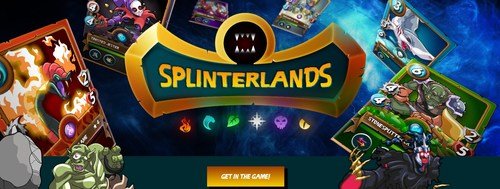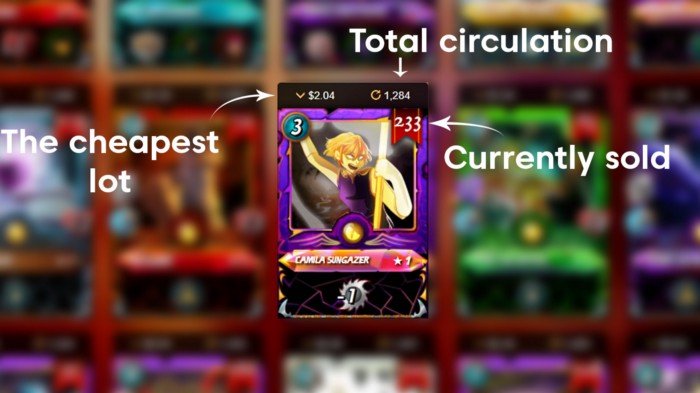How to play and earn with Splinterlands

Splinterlands, the biggest blockchain hit.Leaning on the card game classics like Magic: The Gathering, Splinterlands adapts their complexity for mainstream users and brings true ownership of the battle units into the fold. In this guide, we will take a quick look at the main mechanics, the tricky parts and everything it takes to make you a tactical mastermind!
Signing up on Splinterlands
Splinterlands is optimized for desktop, so we recommend using Hive Keychain Chrome extension to log in and play Splinterlands with. But it’s equally as enjoyable to play on mobile!
Getting started
Splinterlands awards you with a starter set of cards that you can use to battle. However, these are lent to you, which means you don’t own them. To start building your own collection of playable NFT cards, you’re required to buy Summoner’s Spellbook for 10 USD. While it may seem far off from the industry-standard play-to-earn formula, it prevents the cards from devaluation.
Despite the active Marketplace and general attractiveness for collectors (different card designs and editions, etc.), in the end of things, most earning mechanics rely on combat, so we will focus a bit more on this. You will need this info to build more powerful decks and get more loot.
Your cards
All Splinterlands cards have two types: Summoners and Monsters. Summoners are ‘the commanders’ of Monsters that do the fighting.
Regardless of the type, they share some fundamental attributes.
- Foil. A Gold Foil means a higher rarity. If you’re not planning on turning into a collector, those are only valuable for you as potential sale items.
- Splinter. It’s a special element that defines a card’s affinity. It plays a bigger role in the context of Quests and battle conditions (we will cover those a bit later on). For Summoners, Splinters limit the selection of monsters they can command.
- Mana. It reflects the card’s power and is essential for building Teams.
- Level. Increasing the level may lead to new abilities or an increase in STATS. To level a card up, you will need to merge same Monster or Summoner cards into one.
- Rarity. The rarer it is, the more profitable sale it will make!
- Abilities. Special skills or effects. Summoners usually boost your cards or afflict the enemy negatively. For Monsters, the Abilities list is quite extensive, you can read more about those here.
- Monster cards also have STATS. These include:
- Speed. How fast your characters are in combat.
- Damage. Your Monsters can deal Melee, Ranged and Magical damage. The last two types can only be done from the second line of the formation, so position your Monsters wisely. Pay attention to their Abilities — for some Monsters, this rule may not apply.
- Toughness. Some of your Monsters can withstand more attacks without losing life, and you’ve got Toughness to thank for that!
- Life. Your Monsters aren’t immortal. If they’re out of life quickly, they’re out of the battle.
Your battles
To challenge other players, go to the Battle screen from the top icons row. You will notice a big green tutorial button: tap or click on the arrows on it to switch to either Practice or Ranked encounters.
Every battle starts with a small pop-up with some info about your opponent, the Mana cap and special conditions. Conditions could be anything from limiting both teams to a certain Splinter or prohibiting Flying Monsters from battling.
Splinterlands finds you an opponent first and sets battle rules. These rules will always change from battle to battle.
Next, you will need to choose a formation for your team. Think of it as their positions in the linear order. Position 1 can only be occupied by Monsters with Melee damage (unless their Ability allows them to perform Ranged or Magic attacks from it). All the other positions are reserved for Ranged and Magic attacks — again, unless your Monsters’ abilities go around this rule.
If you find the conditions acceptable, proceed to make a team. Remember, you only have two minutes for it. Pay attention to the cards’ Attributes and try to compensate your weak points with the Summoner card.
Key takeaways
- Don’t rush into Ranked battles head first. Complete at least a couple of dozens of Practice ones to make sure you really got a hang of the game and are keen on your current deck.
- Make use of your starter position. As long as you stay below 100 rating, you don’t suffer any rating penalty for losing. This is the perfect time to get more cards and experiment.
- Study your cards in advance. You will never have enough time to study those after accepting the battle conditions. It would also help to create some kind of presets for various Mana caps or conditions. Your main goal is to build a team that is diverse in its Abilities where every card strengthens one another. For example, a tank card with a taunting ability goes well with Ranged or Magical attack cards with high damage and low health.
- Check for Quests! Quests are a great way to get loot more often. Most of these work in the same way as conditions, prompting you to win battles with a particular Splinter or something similar.
The earning ways
- Now that you’re a battlefield pro, let’s talk earning. There are four types of assets you can earn in the game:
- Cards. No mystery here — pick some to enhance your Monster teams, keep duplicates for leveling up and sell or convert the rest into DEC. It should be noted that Reward cards belong to a separate edition, so some of those may pick up on value later on.
- Potions. Use those to increase the drop rates of rarer cards, get more loot chests or receive a mystery prize.
- Dark Energy Crystals (DEC) — tradeable cryptocurrency that you get for winning ranked battles, unlocking loot chests and selling cards on the marketplace.
- Splinterlands Shards (SPS) — also a tradeable cryptocurrency available on a larger variety of blockchains, allowing you to not only earn but partake in the game’s governance. Because of SPS’s major role in player’s rewards and agency, we dedicated a separate blog post to it.
How to earn more from battles
Climb up the leaderboard. All players on Splinterlands belong to a league and, within it, a tier. The further up you are, the more rewards you get. You will advance faster if you take on opponents with higher ratings.
Time your battles. Splinterlands runs in seasons, which typically take about 15 days. It’s in your best interest to get into the highest league possible, so take advantage of the time you have before rewards are distributed. Timing also matters when mining DEC through battles — the DEC capture rate decreases by 1% per win. That means, if you had a 50 battles winning strike in one day, the last win will only get you half the DEC tokens you were supposed to get. Keep that in mind and don’t be greedy — unless you don’t care about earning DEC in the beginning and would rather get into a higher League first.
How to earn more from Marketplace sales
We have already established some ground sales rules: Gold Foil and higher rarity equal higher sales. There are a couple of other nuances though. Let’s take a look at the anatomy of a Marketplace card.
You want to pay attention to three parameters here.
First of all, take a look at how many of these exact same cards are being sold — that’s a red banner in the upper right corner. Your chances of making a profit decrease with every other person selling the same item as you. Watch the Marketplace closely and try to only put out the cards with fewer offers.
Next is the lowest price a seller is asking for that card. Consider your initial investments and see if you can match this offer with an even sweeter deal or if it would make more sense to pass it up — for now.
Finally, there’s the current circulation. This doesn’t have an immediate effect on sales, but typically, cards with a lot of supply won’t sell high, simply because they aren’t that rare.
We must warn you against putting cards out for sale blindly. Chances are, there are hundreds of people making the exact same mistake. Some cards will serve you better in the long run when you climb the ratings. Be level-headed and strategic about it.

Selling DEC tokens
Here comes the tricky part. DEC is fully compatible with Hive, BinanceChain , Ethereum and Tron. In order to withdraw first, you need to have a wallet on one of these networks. Those who’d rather swap it for ETH can do so on Uniswap.
As Dark Energy Crystals are directly tradeable on TronTrade, we recommend Tron.
Once you set everything up, link your wallet with your Splinterlands account
After you set everything up, it’s time to withdraw the DEC! Tap or click on your DEC balance and choose the amount you want to withdraw and where you’re sending it. As soon as tokens land in your wallet, you can trade them for money or other cryptos of the same standard.
Wrapping up
Even with comparably simple mechanics, Splinterlands may seem challenging at first. But as soon as you wrap your mind around all its quirks and strategic workflows, you’ll find yourself getting back all that money you spent on the Summoner’s Spellbook in no time!
Congratulations @kriptovalute! You have completed the following achievement on the Hive blockchain and have been rewarded with new badge(s):
Your next target is to reach 900 upvotes.
You can view your badges on your board and compare yourself to others in the Ranking
If you no longer want to receive notifications, reply to this comment with the word
STOPCheck out the last post from @hivebuzz: